This post will help you understand how to Enable Screen Saver Policy Using Intune. We are going to use Configuration Profiles of Intune to implement this policy. Our main purpose here is to help you acquire knowledge of how to Enable Screen Saver Policy Using Intune
.Activating Enable Screen Saver Policy Using Intune enables the functionality of desktop screensavers. If you choose to deactivate this preference, screensavers will not initiate. Additionally, turning off this option will make the Screen Saver section inaccessible within the Screen Saver dialog found in the Personalization or Display Control Panel.
Consequently, users will be unable to modify screensaver preferences. In the absence of configuration, this option will have no impact on the system. Enabling it will prompt a screensaver to operate, contingent upon two conditions being met: firstly, a valid screensaver must be specified on the client either through the “Screen Saver executable name” setting or the Control Panel on the client’s computer; secondly, the screensaver timeout must be established as a nonzero value via the setting or Control Panel. Additional information can be found in relation to the “Prevent changing Screen Saver” setting.
Enabling the mentioned setting triggers the activation of screensavers on the desktop. If, however, this setting is disabled, screensavers will not engage when the computer is idle. Furthermore, disabling the setting also disables the Screen Saver section within the Screen Saver dialog, which is typically found in the Personalization or Display Control Panel. This action effectively restricts users from modifying any screensaver-related options through these control panels.

- Password Protected Screen Saver Policy using Intune
- Configure Solicited Remote Assistance Policy using Intune
Windows CSP Details CPL_Personalization_EnableScreenSaver
We will see Windows CSP Details for this Policy setting CPL_Personalization_EnableScreenSaver. This feature pertains to the management of desktop screensavers within a computer’s operating system. Screensavers are visual displays that activate after a period of inactivity on a computer screen, serving both as a protective measure to prevent screen burn-in and as a visually pleasing element. Should this setting remain unconfigured, it will not produce any impact on the overall system.
CSP URI – ./User/Vendor/MSFT/Policy/Config/ADMX_ControlPanelDisplay/CPL_Personalization_EnableScreenSaver

Enable Screen Saver Policy using Intune
To set the Enable Screen Saver Policy Using Intune, follow the steps stated below:
- Sign in to the Intune Admin Center portal https://intune.microsoft.com/.
- Select Devices > Windows > Configuration profiles > Create a profile.
In Create Profile, I select Windows 10 and later in Platform and select Profile Type as Settings catalog. Click on Create button.
| Platform | Profile Type |
|---|---|
| Windows 10 and later | Settings Catalog |
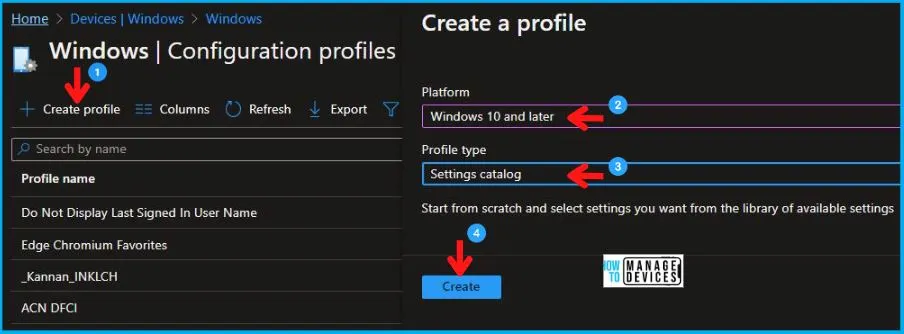
On the Basics tab pane, I provide a name for the policy as “Enable Screen Saver Policy.” Optionally, if you want, you can enter a policy description and proceed by selecting “Next.”
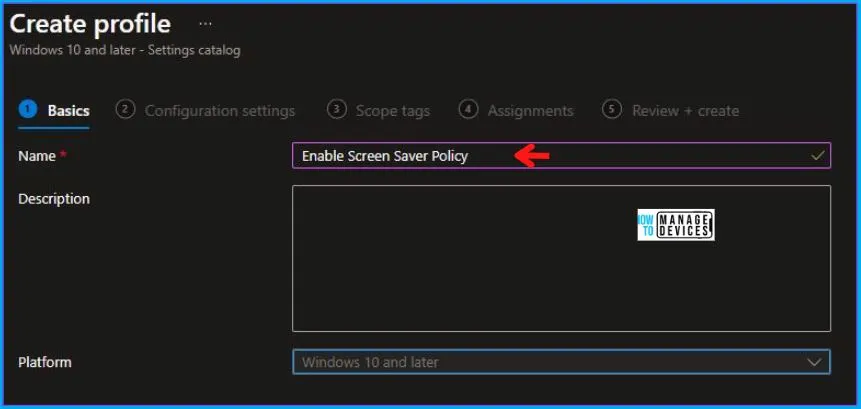
Now in Configuration Settings, click Add Settings to browse or search the catalog for the settings I want to configure.
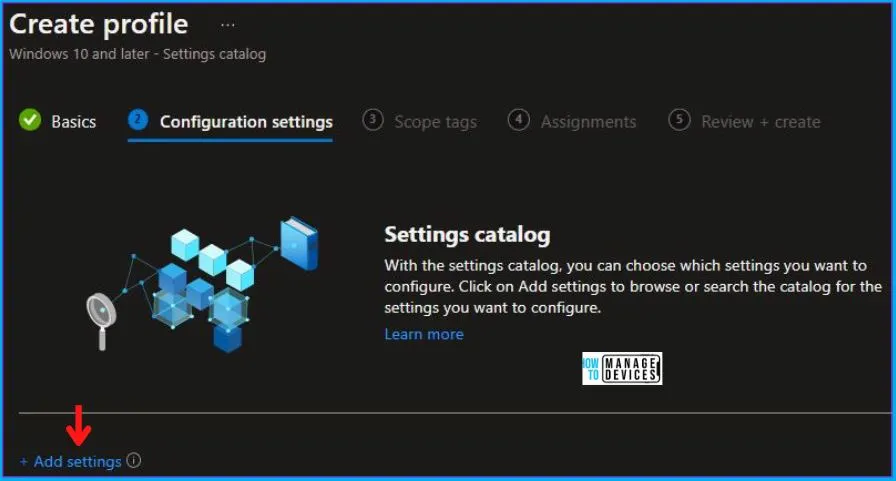
In the Settings Picker windows, I searched for the keyword Screen Saver, I found the category Administrative Templates\Control Panel\Personalization and selected this.
When I select that option as stated above, I see one sub-category among many, Enable screen saver (User). After selecting that, click the cross mark at the right-hand corner, as shown below.
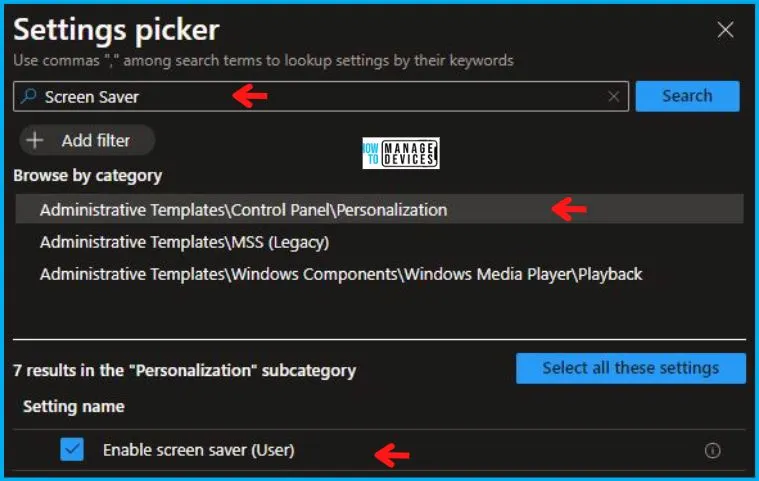
I kept the Enable screen saver (User) as Enabled in the Administrative Templates and clicked on Next to continue.
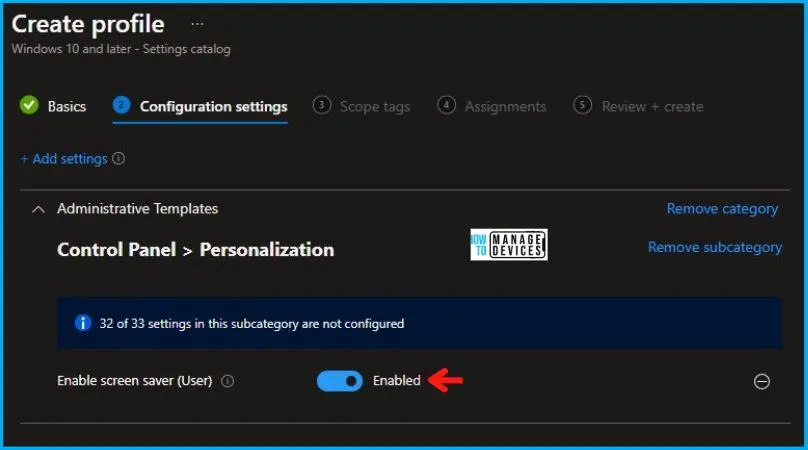
Using Scope tags, you can assign a tag to filter the profile to specific IT groups. One can add scope tags (if required) and click Next to continue. Now in Assignments, in Included Groups, you need to click on Add Groups, choose Select Groups to include one or more groups, and click Next to continue.
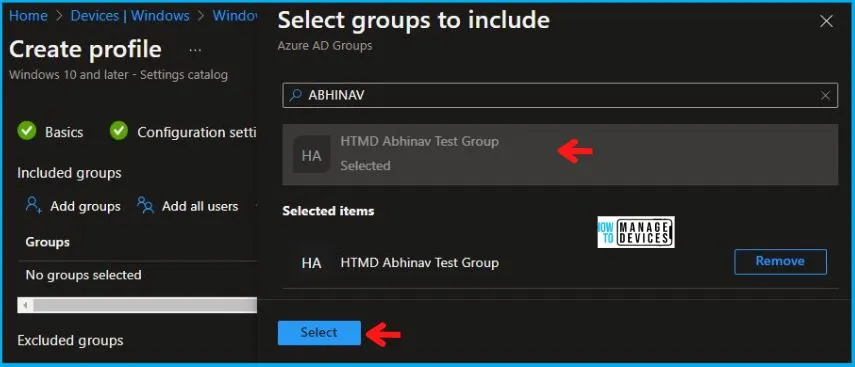
In the Review + Create tab, I review settings. After clicking on Create, changes are saved, and the profile is assigned.
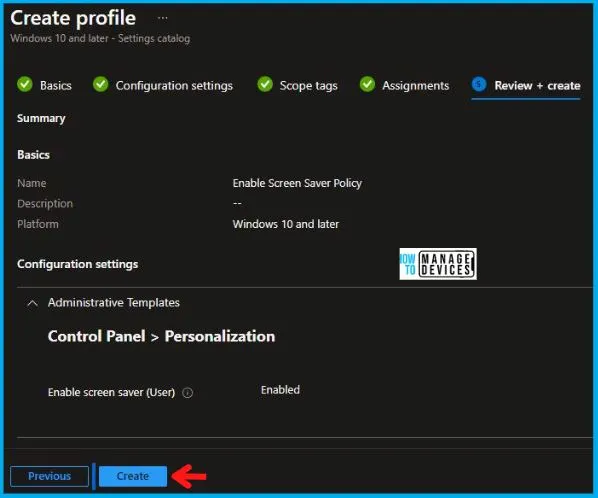
Upon successfully creating the “Enable Screen Saver Policy,“ notification will appear in the top right-hand corner, confirming the action. You can also verify the policy’s existence by navigating to the Configuration Profiles list, where it will be prominently displayed.
Your groups will receive your profile settings when the devices check in with the Intune service. The Policy applies to the device.
Intune Report for Enable Screen Saver Policy
From Intune Portal, you can view the Intune settings catalog profile report, which provides an overview of device configuration policies and deployment status.
To track the assignment of the policy, you need to select the relevant policy from the Configuration Profiles list. Reviewing the device and user check-in status lets you determine if the policy has been successfully applied. If you require more detailed information, you can click on “View Report” to access additional insights.
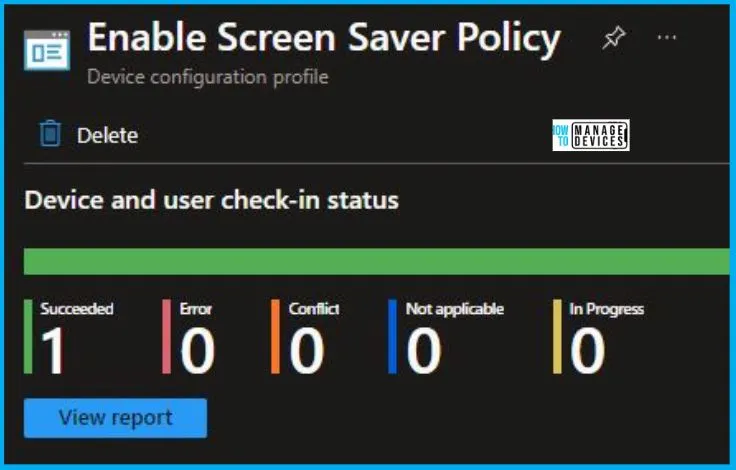
Intune MDM Event Log
To verify the successful implementation of String or integer policies on Windows 10 or 11 devices through Intune, you can leverage event IDs 813 and 814. These event IDs provide valuable insights into the application status of the policy as well as the specific value assigned to the policy on those devices. In the case of this particular policy, the value is String and is linked to the event ID 814.
By analyzing these event IDs, you can gain a clear understanding of the policy’s application status and the corresponding value associated with it on the devices in question.
To confirm this, you can check the Event log path – Applications and Services Logs – Microsoft – Windows – Devicemanagement-Enterprise-Diagnostics-Provider – Admin.
MDM PolicyManager: Set policy string, Policy: (CPL_Personalization_EnableScreenSaver), Area: (ADMX_ControlPanelDsiplay), EnrollmentID requesting merge: (5B88AEF1-09E8-43BB-B144-7254ACBBDF3E), Current User: (S-1-12-13186897695-1137825691-1845872004-278613382), String: (<enabled/>), Enrollment Type: (0x6), Scope: (0x1).
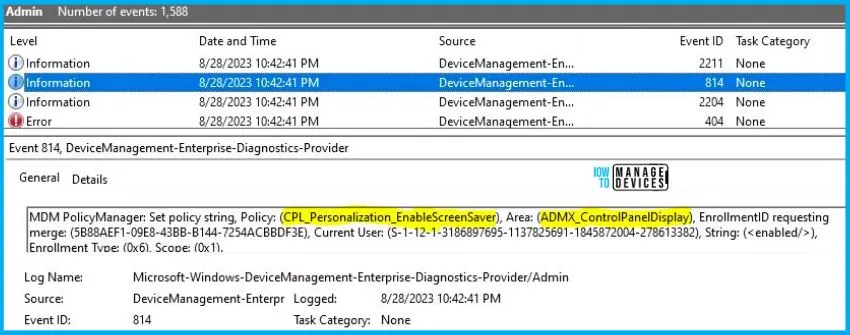
When I opened the above Event log, I found that the policy I had applied to the device was successfully implemented. By reviewing the log entry shown in the above image, the Event Viewer, I came across essential information, including the Area and Enrollment ID. These details play a significant role in identifying the corresponding registry path. To locate the specific information, please consult the table provided below:
| Area | Policy | String | Scoped | Event ID |
|---|---|---|---|---|
| ADMX_ControlPanelDsiplay | CPL_Personalization_EnableScreenSaver | Enabled | User | 814 |
The details presented in the table above for the Enable Screen Saver Policy Using Intune can be employed to access the registry settings that hold the group policy configurations on a specific computer. To accomplish this, you can execute “REGEDIT.exe” on the target computer and navigate to the precise registry path where these settings are stored.
- Computer\HKEY_LOCAL_MACHINE\SOFTWARE\Microsoft\PolicyManager\providers\5B88AEF1-09E8-43BB-B144-7254ACBBDF3E\default\S-1-12-13186897695-1137825691-1845872004-278613382\ADMX_ControlPanelDsiplay
When you navigate the above path in the Registry Editor, you will find the registry key named CPL_Personalization_EnableScreenSaver. Also, when I navigated to the above path, I saw that the Registry Key was created.
| Registry Name | Value |
|---|---|
| CPL_Personalization_EnableScreenSaver | Disabled |

Author
Abhinav Rana is working as an SCCM Admin. He loves to help the community by sharing his knowledge. He is a B.Tech graduate in Information Technology.

Hi Anoop,
What about the SCR file that we need to use for screensaver where should i copy can i use Azure Blob Storage? Im planning to customize the screensaver with some of our Project Photos.